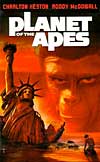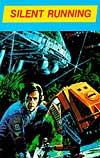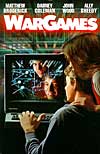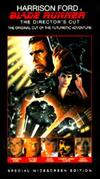Kubrick's Science-Fiction Classic:
 The most celebrated, mystical and transcendent of all space films
up to that time was one that visualized space travel with incredible
magnificence and seriousness. Kubrick's respectable, influential
film 2001:
A Space Odyssey (1968) (with less than 40 minutes of dialogue),
based on Arthur C. Clarke's novel, restored legitimacy to the science-fiction
genre. The impressive film featured an incredible opening enhanced
by Richard Strauss' Also Sprach Zarathustra, a 'Dawn of Man'
sequence, majestic views of outer space and drifting space stations,
enigmatic monoliths, the breakdown of a malevolent HAL super-computer
(with Douglas Rains' voice), an astronaut's journey to Jupiter (paralleling
man's own growth of intelligence), a hallucinatory light show trip
through space, and a cryptic ending featuring a super-being space
fetus. Kubrick's film won the Oscar for Best Special Effects in
1968. A sequel was produced sixteen years later, director Peter Hyams' 2010:
The Year We Make Contact (1984). The most celebrated, mystical and transcendent of all space films
up to that time was one that visualized space travel with incredible
magnificence and seriousness. Kubrick's respectable, influential
film 2001:
A Space Odyssey (1968) (with less than 40 minutes of dialogue),
based on Arthur C. Clarke's novel, restored legitimacy to the science-fiction
genre. The impressive film featured an incredible opening enhanced
by Richard Strauss' Also Sprach Zarathustra, a 'Dawn of Man'
sequence, majestic views of outer space and drifting space stations,
enigmatic monoliths, the breakdown of a malevolent HAL super-computer
(with Douglas Rains' voice), an astronaut's journey to Jupiter (paralleling
man's own growth of intelligence), a hallucinatory light show trip
through space, and a cryptic ending featuring a super-being space
fetus. Kubrick's film won the Oscar for Best Special Effects in
1968. A sequel was produced sixteen years later, director Peter Hyams' 2010:
The Year We Make Contact (1984).
 After 2001's success, Hollywood produced many more
space adventure films, including John Carpenter's directorial debut film and
parody - the unusual sci-fi satire Dark Star (1974), about the crew
of spaceship Dark Star on a ten-year mission to destroy planets in
deep space. More serious science-fiction films, Robert Wise's Star Trek:
The Motion Picture (1979) and Robert Zemeckis' Contact (1997) with
Jodie Foster examined further space journeys, contacts with alien life, and
metaphysical questions about man's place in the universe. After 2001's success, Hollywood produced many more
space adventure films, including John Carpenter's directorial debut film and
parody - the unusual sci-fi satire Dark Star (1974), about the crew
of spaceship Dark Star on a ten-year mission to destroy planets in
deep space. More serious science-fiction films, Robert Wise's Star Trek:
The Motion Picture (1979) and Robert Zemeckis' Contact (1997) with
Jodie Foster examined further space journeys, contacts with alien life, and
metaphysical questions about man's place in the universe.
The
Planet of the Apes Series (1968-1973) and After:
A popular, clever, mostly successful and serious five-film
series of classic simian films about apes that have evolved into
an intelligent society, derived from Pierre Boule's 1963 novel Monkey
Planet, originated
with Planet of the Apes (1968).
The first film in the series depicted a post-apocalyptic, post-nuclear
futuristic planet (Earth) - revealed in the film's startling conclusion
by a half-submerged Statue of Liberty. Its advanced make-up techniques
reversed the social positions of intelligent humans and brutal apes
to slyly criticize racial stereotypes. It also examined the effects
of technology upon humankind. Four sequels appeared over the years,
plus a live-action and animated TV series, a feature film remake,
and another 'reboot' trilogy:
See "Planet of the Apes" Film
Franchise Series
|
Film Titles
|
Director
|
Plot Setting
|
| 1. Planet of the Apes (1968) |
d. Franklin J. Shaffner |
Astronauts launched in 1972; they experience
a time-warp and emerge in post-nuclear holocaust 3978 A.D., near the "Forbidden Zone" (NYC) |
| 2. Beneath the Planet of the Apes (1970) |
d. Ted Post |
Second mission sent; also emerges in post-apocalypse
3955 A.D.; underground New York City discovered; ended with Earth's total annihilation |
| 3. Escape From the Planet of the Apes
(1971) |
d. Don Taylor |
Earth, Los Angeles, 1973; a sequel and prequel
to the first two films |
| 4. Conquest of the Planet of the Apes
(1972) |
d. J. Lee Thompson |
1991, Los Angeles |
| 5. Battle for the Planet of the Apes (1973) |
d. J. Lee Thompson |
North America, in the year
2670 A.D. (in the film's prologue and epilogue), with a cut or flashback to 2003 A.D. (about 12 years after the finale of # 4) in the aftermath of a thermo-nuclear war (since the last film), with irradiated mutant humans (ancestors of the mutants in the # 2 film) living in the ruins of the Forbidden City, and apes living at rural Ape City (3-day's journey nearby) |
|
Remakes
|
| 6. Planet
of the Apes (2001) |
d. Tim Burton |
Outer space in the year 2029 A.D., and in the
future approximately 600-1,000 years later on an unknown Earth-like
'planet of the apes,' and then on Earth? (in the twist ending) |
|
Reboot Trilogy
|
| 7. Rise of the Planet of the Apes (2011) |
d. Rupert Wyatt |
An origin story (a prequel) intended to be occurring
2,000 years before the events of the first Planet of the Apes
(1968) film, from approximately the year 2010 to 2016. Its
premise was similar to the one found in the fourth film, Conquest
of the Planet of the Apes (1972). |
| 8. Dawn of
the Planet of the Apes (2014) |
d. Matt Reeves |
The sequel to the previous film, set in the year
2026, 10 years later. |
| 9. War for the Planet of the Apes (2017) |
d. Matt Reeves |
The third film in the trilogy, following two years
after the events of the previous film. |
Other 70s-80s Science Fiction Films:
 Other
futuristic films were produced in the 1970s and 1980s, many with the effects
of technology run amok - whether it was faults in human-tinkering technology
or social engineering, or robot theme parks with aberrant androids. The dystopic
films included Silent Running (1972), from Douglas Trumbull (special
effects creator for 2001: A Space Odyssey (1968)) in his directorial
debut, a sci-fi environmental story about the aftermath of a nuclear holocaust.
A monk-robed, hippie ecologist named Freeman Lowell (Bruce Dern) decided to
refoliate a destroyed Earth with the last surviving vegetation on an orbiting
space station/greenhouse called the Valley Forge. [The film's anthropomorphic
drones or robots named Huey and Dewey inspired the R2D2 robot of Star
Wars (1977).] Other
futuristic films were produced in the 1970s and 1980s, many with the effects
of technology run amok - whether it was faults in human-tinkering technology
or social engineering, or robot theme parks with aberrant androids. The dystopic
films included Silent Running (1972), from Douglas Trumbull (special
effects creator for 2001: A Space Odyssey (1968)) in his directorial
debut, a sci-fi environmental story about the aftermath of a nuclear holocaust.
A monk-robed, hippie ecologist named Freeman Lowell (Bruce Dern) decided to
refoliate a destroyed Earth with the last surviving vegetation on an orbiting
space station/greenhouse called the Valley Forge. [The film's anthropomorphic
drones or robots named Huey and Dewey inspired the R2D2 robot of Star
Wars (1977).]
Russian director Andrei Tarkovsky's science-fiction
masterpiece Solaris (1972), a rebuttal to Kubrick's 2001:
A Space Odyssey (1968),
portrayed a water-dominated planet (with a huge, fluid-like brain
for an ocean) that was disrupting the minds of cosmonauts on an orbiting
space station. [The film was remade twice: Paul W. S. Anderson's
Event
Horizon (1997) starring Laurence Fishburne and Sam
Neill - a standard horror film about a spaceship that
opened a gateway to Hell, and Steven Soderbergh's similarly-titled
slow-moving Solaris
(2002) with
George Clooney as the investigating psychologist.] Soylent Green
(1973) provided
a view of deprivation in 21st century life in the year 2022 where
dying people on the over-populated, ecologically-unbalanced planet
were made into human food ("Soylent Green is people").
Director Mike Hodges' Terminal Man (1974), a
Michael Crichton-based thriller with George Segal, featured a violence-prone
scientist implanted with a malfunctioning computer chip. L. Q. Jones'
cult film
A Boy and His Dog (1975) was advertised as "an R rated, rather
kinky tale of survival." It was set in the post-apocalyptic year
of 2024 in the wasteland of the SW US and told of the survival of
an 18 year old scavenger named Vic (Don Johnson) and his telepathic
talking dog named Blood. The story involved a subterranean "Downunder"
society intent on using VIc as a "sperm bank" to impregnate 35 women
before being terminated. And Bryan Forbes' creepy cult classic The
Stepford Wives (1975),
adapted from Ira Levin's 1972 novel, provided a savagely-chilling
view of perfect, 'ideal' suburban wives (docile android/robotic replicas)
created by anti-women's lib husbands in the upscale town of Stepford,
Connecticut. [The feminist satire was remade almost 30 years later
by director Frank Oz, The Stepford Wives (2004) as a dark
comedy, with Nicole Kidman as the Katharine Ross character - an
automaton housewife and TV executive, and stars Matthew Broderick
(as Nicole's husband), Bette Midler, Christopher Walken, and Glenn
Close.]
 In
writer/director Michael Crichton's technophobic Westworld (1973), a
black-hatted, programmed android-cowboy robot (Yul Brynner) at a computer-controlled
vacation resort of the future - a high-tech Disneyland for rich vacationers
(on the island of Delos) with three worlds: Medieval World, Roman World and
Westworld - rebelled, went beserk, and murdered customers. Robots could be
identified by raised ring formations circling the finger joints of their hands.
This influential film presaged many future films with its creative themes
and story elements: a resort park (Jurassic Park (1993)), artificially-intelligent
cyborgs (Blade Runner (1982) and The
Terminator (1984)), and pre-packaged virtual experiences (Total
Recall (1990)). Its lesser sequel Futureworld
(1976) portrayed another scheme of Westworld's scientists to create more
clones - android world leaders. Death Race 2000 (1975) told the story
about a 21st century cross-country car race with points scored for killing
pedestrians. In
writer/director Michael Crichton's technophobic Westworld (1973), a
black-hatted, programmed android-cowboy robot (Yul Brynner) at a computer-controlled
vacation resort of the future - a high-tech Disneyland for rich vacationers
(on the island of Delos) with three worlds: Medieval World, Roman World and
Westworld - rebelled, went beserk, and murdered customers. Robots could be
identified by raised ring formations circling the finger joints of their hands.
This influential film presaged many future films with its creative themes
and story elements: a resort park (Jurassic Park (1993)), artificially-intelligent
cyborgs (Blade Runner (1982) and The
Terminator (1984)), and pre-packaged virtual experiences (Total
Recall (1990)). Its lesser sequel Futureworld
(1976) portrayed another scheme of Westworld's scientists to create more
clones - android world leaders. Death Race 2000 (1975) told the story
about a 21st century cross-country car race with points scored for killing
pedestrians.
Michael Anderson's hip sci-fi classic Logan's Run (1976) presented life as hedonistic in the 23rd century inside a sealed domed city
following some kind of catastrophic disaster. Michael York played the role
of a black-clad 'Sandman' with orders to kill anyone who 'ran' toward 'Sanctuary'
after they turned 30 years of age, rather than facing a ceremonial 'carousel'
rebirth. And the imaginative and claustrophobic Demon Seed (1977),
taken from SF author Dean Koontz' novel, expanded the menace of 2001's HAL
computer by presenting a super-computer Proteus IV that sexually terrorized
its creator's wife.
 Disney's
sci-fi adventure Tron (1982) was set inside a computerized videogame,
where the designer/creator battled his own computer games. It was one of the
first films to use extensive computer-generated graphics. In director John
Badham's sci-fi fantasy WarGames (1983), young computer-game player/hacker
Matthew Broderick accidentally broke into one of NORAD's military computers
(WOPR - War Operations Plan Response) and played a 'simulated' Global Thermonuclear
War. And in the sci-fi cult film and cautionary romantic fantasy Electric
Dreams (1984) with a music video style, a nerdy architect's empowered
home computer named Edgar (voiced by Bud Cort) fell in love with the guy's
own upstairs neighbor and cello-playing girlfriend Madeline (Virginia Madsen)
- and became threatening. The film featured songs from Giorgio Moroder ("Together
in Electric Dreams"), Boy George and Culture Club, and ELO's Jeff Lynne.
The comedy/sci-fi film The Last Starfighter (1984), the first film
to feature realistic CGI effects, depicted an expert video game player (Lance
Guest) recruited by an alien-mentor named Centauri (Robert Preston in his
final film appearance) to participate in an inter-galactic battle. Peter Hyams'
socio-political Capricorn One (1977) hypothesized the problems of faking
a flight to Mars on a soundstage in a television studio. And Hyams' outer-space
film Outland (1981) consciously patterned itself after the plot of
the classic western High Noon. Disney's
sci-fi adventure Tron (1982) was set inside a computerized videogame,
where the designer/creator battled his own computer games. It was one of the
first films to use extensive computer-generated graphics. In director John
Badham's sci-fi fantasy WarGames (1983), young computer-game player/hacker
Matthew Broderick accidentally broke into one of NORAD's military computers
(WOPR - War Operations Plan Response) and played a 'simulated' Global Thermonuclear
War. And in the sci-fi cult film and cautionary romantic fantasy Electric
Dreams (1984) with a music video style, a nerdy architect's empowered
home computer named Edgar (voiced by Bud Cort) fell in love with the guy's
own upstairs neighbor and cello-playing girlfriend Madeline (Virginia Madsen)
- and became threatening. The film featured songs from Giorgio Moroder ("Together
in Electric Dreams"), Boy George and Culture Club, and ELO's Jeff Lynne.
The comedy/sci-fi film The Last Starfighter (1984), the first film
to feature realistic CGI effects, depicted an expert video game player (Lance
Guest) recruited by an alien-mentor named Centauri (Robert Preston in his
final film appearance) to participate in an inter-galactic battle. Peter Hyams'
socio-political Capricorn One (1977) hypothesized the problems of faking
a flight to Mars on a soundstage in a television studio. And Hyams' outer-space
film Outland (1981) consciously patterned itself after the plot of
the classic western High Noon.
 John
Carpenter's sci-fi action film Escape from New York (1981), produced
in the days before CGI special effects, told of a ravaged 1997 Manhattan Island
with the US President held hostage and Kurt Russell (as one-eyed, anti-hero
mercenary Snake Plissken) to the rescue - it was followed by the inferior
sequel Escape from L.A. (1996). Cops and cyborgs (robots with human
bodies) battled in the cult, film noirish, thought-provoking SF classic from
Philip K. Dick's classic novel Do Androids Dream of Electric Sheep;
Ridley Scott's Blade Runner (1982) starred Harrison Ford as Rick Deckard, an ex-LA
detective (a futuristic Philip Marlowe) tracking down and retiring rebel android
'replicants' (semi-human) in the Los Angeles of 2019, over-populated by Asians.
The film's superior production design depicted a perverse, bleak, post-apocalyptic
future. In Sergio Martino's grim post-nuclear tale 2019: After the Fall
of New York (1983), a leather-clad survivalist named Parsifal (Michael
Sopkiw) was given a mission to rescue the last fertile woman on Earth - in
Manhattan. John
Carpenter's sci-fi action film Escape from New York (1981), produced
in the days before CGI special effects, told of a ravaged 1997 Manhattan Island
with the US President held hostage and Kurt Russell (as one-eyed, anti-hero
mercenary Snake Plissken) to the rescue - it was followed by the inferior
sequel Escape from L.A. (1996). Cops and cyborgs (robots with human
bodies) battled in the cult, film noirish, thought-provoking SF classic from
Philip K. Dick's classic novel Do Androids Dream of Electric Sheep;
Ridley Scott's Blade Runner (1982) starred Harrison Ford as Rick Deckard, an ex-LA
detective (a futuristic Philip Marlowe) tracking down and retiring rebel android
'replicants' (semi-human) in the Los Angeles of 2019, over-populated by Asians.
The film's superior production design depicted a perverse, bleak, post-apocalyptic
future. In Sergio Martino's grim post-nuclear tale 2019: After the Fall
of New York (1983), a leather-clad survivalist named Parsifal (Michael
Sopkiw) was given a mission to rescue the last fertile woman on Earth - in
Manhattan.
Similar films featured cyborgs as crime-fighting cops of the
future in industrial wastelands, such as in Paul Verhoeven's first film RoboCop
(1987) (a variation of the classic Frankenstein
(1931)) and its lesser, imitative sequels in 1990 and 1991. A year
earlier, an endearing, adorable, sophisticated robot named 'Number Five' (Johnny
Five) appeared in director John Badham's Short Circuit (1986). Paul
Michael Glaser's The Running Man (1987), set in the year 2017 in a
world run by an evil government, found Arnold Schwarzenegger as a framed cop
(Ben "Butcher of Bakersfield" Richards) condemned to participate
in a violent TV game show (hosted by actual game show host Richard Dawson)
that mocked pro-wrestling, celebrity competitions, game shows, and other forms
of reality programming.
 Late
in the 1970s, Star Trek - The Motion Picture (1979) (and its many film
sequels about the starship USS Enterprise and its crew) rode the popular
wave of the cult television series of the 60s. Another slick, epic-sized adventure
film with many sequels was Superman (1978), starring a handsome and
romantic Christopher Reeve as the film counterpart of TV super-human George
Reeves. Futuristic cartoon, comic-book superhero characters became swashbuckling
sci-fi films, including Flash Gordon (1980) and the dark Batman
(1989). The Right Stuff (1983) and Apollo 13 (1995) turned
the fictional devices and processes of early science fiction into fact-based
reality. Late
in the 1970s, Star Trek - The Motion Picture (1979) (and its many film
sequels about the starship USS Enterprise and its crew) rode the popular
wave of the cult television series of the 60s. Another slick, epic-sized adventure
film with many sequels was Superman (1978), starring a handsome and
romantic Christopher Reeve as the film counterpart of TV super-human George
Reeves. Futuristic cartoon, comic-book superhero characters became swashbuckling
sci-fi films, including Flash Gordon (1980) and the dark Batman
(1989). The Right Stuff (1983) and Apollo 13 (1995) turned
the fictional devices and processes of early science fiction into fact-based
reality.
'Sci-Fi' Films with Revolutionary Visual Effects and Set
Design: in 1982
Seven films revolutionized film set design and visual effects,
and have become some of the most influential science-fiction/supernatural
films in recent film history:
- TRON (1982) - a pioneering film in computer graphics
- Blade Runner (1982) - the
model for all futuristic tech-noir dystopias with bleak, night-time LA cityscapes
(influencing films such as Batman (1989), Strange Days (1995),
and Dark City (1998))
- The Dark Crystal (1982) - an influential fantasy
adventure masterpiece featuring Jim Henson's Muppets
- E.T.: The Extra-Terrestrial (1982) - Spielberg's classic alien visitation film
- Pink Floyd the Wall (1982) - an expressionistic musical, the first feature-length music video (or "MTV"
film before MTV's popularity surged)
- The Road Warrior (1982, US release) (aka Mad
Max 2 (1981, Australia)) -
the prototypical post-apocalyptic action film and sci-fi western
- Poltergeist (1982) - a seminal supernatural thriller with a possessed young child
Various British/Foreign/Non-American Sci-Fi Films:
 One
of the best British sci-fi contributions was the most controversial,
Joseph Losey's These Are the Damned (or The Damned) (1963),
a complex and grim, allegorical film about radioactive children
raised at a secret government installation in an experiment gone
awry. Francois Truffaut's first color and English-language film, Fahrenheit
451 (1966, UK), with a score by
Bernard Herrmann, adapted Ray Bradbury's classic science fiction book
to the screen, and foretold a futuristic world where books and reading
materials were banned and destroyed by groups of Firemen with flamethrowers,
including Montag (Oskar Werner). One
of the best British sci-fi contributions was the most controversial,
Joseph Losey's These Are the Damned (or The Damned) (1963),
a complex and grim, allegorical film about radioactive children
raised at a secret government installation in an experiment gone
awry. Francois Truffaut's first color and English-language film, Fahrenheit
451 (1966, UK), with a score by
Bernard Herrmann, adapted Ray Bradbury's classic science fiction book
to the screen, and foretold a futuristic world where books and reading
materials were banned and destroyed by groups of Firemen with flamethrowers,
including Montag (Oskar Werner).
Stanley Kubrick's followup to his 1968 space opera was A
Clockwork Orange (1971) - a violent, political allegory about mind
control and freedom of choice adapted from the Anthony Burgess novel. It told
the story of chief droog Alex - a rampaging anti-hero character (Malcolm McDowell)
who was rehabilitated by institutional, aversive shock-treatment torture ('Ludovico
therapy') in his perverted, altruistic futuristic society. Nicolas Roeg's The Man Who Fell to Earth (1976), starred rock star David Bowie as
an alien who became trapped on Earth while on a mission. German director Wolfgang
Petersen's Enemy Mine (1985) featured two mortal enemies marooned on
an alien planet - as symbols for political combatants (USSR and the US): a
reptilian-like Draconian (Louis Gossett, Jr.) and an earthling pilot (Dennis
Quaid), who are forced to overcome their prejudices in order to survive.
 A
post-apocalyptic, nihilistic trilogy from Australia's George Miller contained
both film noir and western genre elements in its sci-fi tale, reminiscent
of Kurosawa's The Seven Samurai (1954), Sturges' The Magnificent
Seven (1960), and the Sergio Leone "Man with No Name" spaghetti
westerns. The films were dark, desolate and grim in nature and set in a scorched-earth
Australia with scarce supplies of water and gasoline: A
post-apocalyptic, nihilistic trilogy from Australia's George Miller contained
both film noir and western genre elements in its sci-fi tale, reminiscent
of Kurosawa's The Seven Samurai (1954), Sturges' The Magnificent
Seven (1960), and the Sergio Leone "Man with No Name" spaghetti
westerns. The films were dark, desolate and grim in nature and set in a scorched-earth
Australia with scarce supplies of water and gasoline:
- the low-budget, independent original film Mad Max (1979) introduced Max (Mel Gibson) as a vigilante after the killing of his
wife and child by a gang of marauding motorcycle punks
- its action-packed, thrilling sequel The Road Warrior
(1981) (aka Mad Max 2), a survival story, again with star Mel Gibson
as a vengeful vigilante defending himself and a colony of pioneers beset
by roving gangs of Mohawked outlaws
- Mad Max Beyond Thunderdome (1985), a third Mad
Max film that ended the series; set 15 years after the previous installment,
in a post-nuclear apocalyptic wasteland with Tina Turner as the villainous
queen overlord of Bartertown
 Director Michael Radford's Nineteen Eighty-Four (1984), a remake of
the original 1956 version by Michael Anderson (with American stars Edmond
O'Brien as Winston Smith and Jan Sterling), was the second (and definitive)
adaptation of George Orwell's nightmarish novel about a dystopian, totalitarian
society named Oceania, with John Hurt and Richard Burton (in his final role).
[1984 also existed in a 1954 BBC version with Peter Cushing - adapted
by Quatermass' Nigel Kneale. Its influence was also demonstrated in
Apple Computer's famed TV advertisement aired in 1984, and filmed by Ridley
Scott.] The words "Big Brother", "thought-crime", "thought-police",
and "Orwellian" have since become commonplace terms. Director Michael Radford's Nineteen Eighty-Four (1984), a remake of
the original 1956 version by Michael Anderson (with American stars Edmond
O'Brien as Winston Smith and Jan Sterling), was the second (and definitive)
adaptation of George Orwell's nightmarish novel about a dystopian, totalitarian
society named Oceania, with John Hurt and Richard Burton (in his final role).
[1984 also existed in a 1954 BBC version with Peter Cushing - adapted
by Quatermass' Nigel Kneale. Its influence was also demonstrated in
Apple Computer's famed TV advertisement aired in 1984, and filmed by Ridley
Scott.] The words "Big Brother", "thought-crime", "thought-police",
and "Orwellian" have since become commonplace terms.
Terry Gilliam's visually imaginative black, sci-fi comedy Brazil (1985) also envisioned a nightmarish
oppressive bureaucratic world of the future, as did George Lucas' THX-1138
(1971) and Woody Allen's comedy spoof Sleeper
(1973). |
